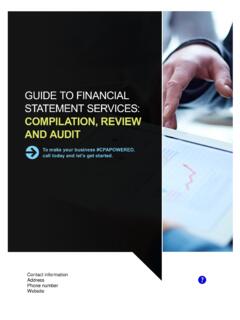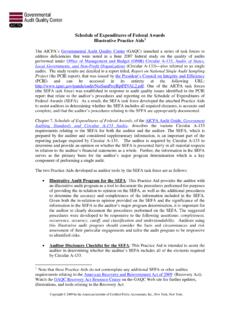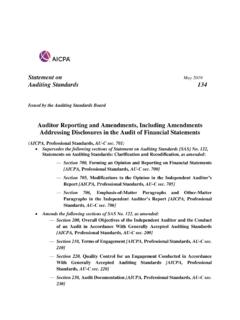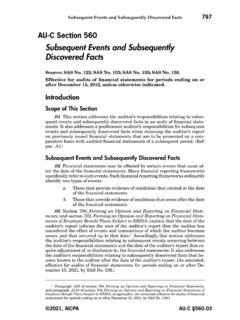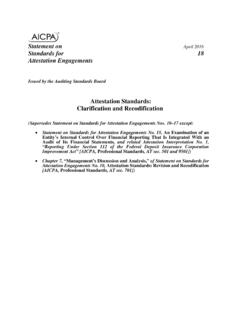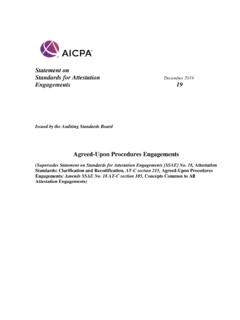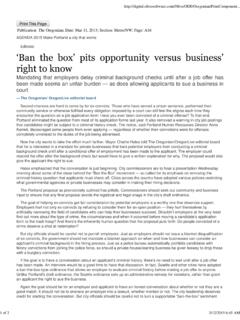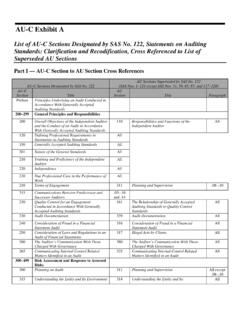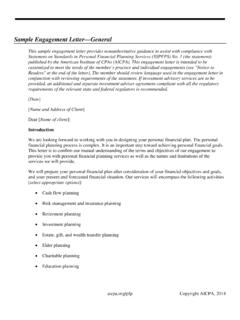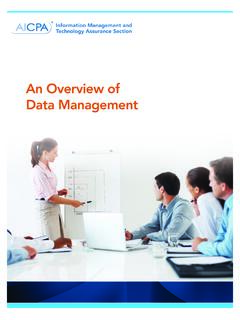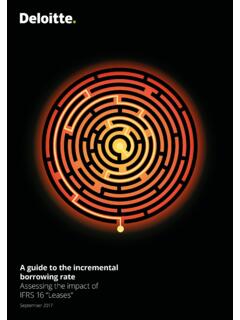Transcription of Financial Reporting Brief: Roadmap to Understanding the ...
1 September2016 Financial Reporting CenterFinancial Reporting Brief: Roadmap to Understanding the New Revenue Recognition Standards In May 2014, FASB issued Accounting Standards Update (ASU) 2014-09, Revenue from Contracts with Customers (Topic 606), and the International Accounting Standards Board (IASB) issued International Financial Reporting Standards ( ifrs ) 15, Revenue from Contracts with Customers. FASB and the IASB have basically achieved convergence with these standards, with only some minor differences that will be discussed later in this ASU No. 2014-09 will amend FASB Accounting Standards Codification (ASC) by creating Topic 606, Revenue from Contracts with Customers and Subtopic 340-40, Other Assets and Deferred Costs Contracts with Customers.
2 The FASB also issued the following amendments to ASU No. 2014-09 to provide clarification on the guidance: ASU No. 2015-14, Revenue from Contracts with Customers (Topic 606) Deferral of the Effective Date ASU No. 2016-08, Revenue from Contracts with Customers (Topic 606) Principal versus Agent Considerations (ReportingRevenue Gross Versus Net) ASU No. 2016-10, Revenue from Contracts with Customers (Topic 606) Identifying Performance Obligations and Licensing ASU No. 2016-12, Revenue from Contracts with Customers (Topic 606) Narrow-Scope Improvements and PracticalExpedientsPublic entities1 are required to adopt the revenue recognition standards for Reporting periods beginning after December 15, 2017, and interim and annual Reporting periods thereafter (which equates to January 1, 2018 for public entities with a December 31 year-end).
3 Earlier application would be permitted only as of annual Reporting periods beginning after December 15, 2016, including interim Reporting periods within that Reporting period. All other entities are required to apply the revenue recognition standard for annual Reporting periods beginning on or after December 15, 2018, and interim Reporting periods within annual Reporting periods beginning after December 15, 2019. Application would be permitted earlier only as of an annual Reporting period beginning after December 15, 2016, including interim Reporting periods within that Reporting period, or an annual Reporting period beginning after December 15, 2016, and interim Reporting 1 A public entity is an entity that is any one of the following.
4 Public business entity not-for-profit entity that has issued, or is a conduit bond obligor for, securities that are traded, listed, or quoted on an exchange or an over-the-counter market employee benefit plan that files or furnishes Financial statements to the SECS eptember 2016 Financial Reporting periods within annual Reporting periods beginning one year after the annual Reporting period in which an entity first applies the guidance in ASU No. 2014-09. This document reorganizes the guidance contained in Topic 606 , to follow the five-step revenue recognition model along with other guidance impacted by this standard.
5 Additionally, it provides references to applicable examples in the implementation guidance. Scope Who Should Apply the Guidance FASB ASC 606-10-15-2 through 15-4 The revenue recognition standard affects all entities public, private, and not-for-profit that either enters into contracts with customers to transfer goods or services or enters into contracts for the transfer of nonfinancial assets unless those contracts are within the scope of other standards (for example: leases and insurance contracts). Financial instruments, guarantees (other than product or service warranties), and nonmonetary exchanges between entities in the same line of business to facilitate sales to customers or potential customers are also scoped out.
6 The revenue recognition standard explains that To achieve the core princple of Topic 606, an entity should take the following actions: Revenue is recognized when a company satisfies a performance obligation by transferring a promised good or service to a customer (which is when the customer obtains control of that good or service). An entity should consider the terms of the contract and all relevent facts and circumstances when applying the revenue recognition standard. An entity should apply the revenue recognition standard, including the use of any practical expedients, consistently to contracts with similar characteristics and in similar circumstances.
7 Step 1: Identify the contract with a customer Step 2: Identify the performance obligations in the contract Step 3: Determine the transaction price Step 4: Allocate the transaction price Step 5: Recognize revenue when or as the entity satisfies aperformance obligationThe core principle of Topic 606 is that an entity should recognize revenue to depict the transfer of goods or services to customers in an amount that reflects the consideration to which the entity expects to be entitled in exchange for those goods or services. FASB ASC 606-10-05-3 through 05-4 and 606-10-10-2 through 10-4 3 Practical Expedient: The revenue recognition standard prescribes accounting for an individual contract with a customer, but allows for application of the guidance to a portfolio of contracts (or performance obligations) with similar characteristics if the entity reasonably expects that the effects on the Financial statements of applying this guidance to the portfolio would not differ materially from applying this guidance to the individual contracts (or performance obligations) within that portfolio.
8 The revenue recognition standard prescribes that an entity should account for a contract with a customer that is within its scope only when all of the following criteria are met: parties to the contract have approved the contract (in writing, orally, or in accordance with other customarybusiness practices) and are committed to perform their respective entity can identify each party s rights regarding the goods or services to be entity can identify the payment terms for the goods or services to be contract has commercial substance (that is, the risk, timing, or amount of the entity s future cash flows is expectedto change as a result of the contract).
9 Is probable that the entity will collect substantially all of the consideration to which it will be entitled in exchange forthe goods or services that will be transferred to the customer (collectability threshold). In evaluating whethercollectability of an amount of consideration is probable, an entity should consider only the customer s ability andintention to pay that amount of consideration when it is due. The amount of consideration to which the entity will beentitled may be less than the price stated in the contract if the consideration is variable because the entity may offer thecustomer a price Contract FASB ASC 606-10-25-2 through 25-8 A contract is an agreement between two or more parties that creates enforceable rights and obligations.
10 Enforceablity of the rights and obligations in the contract is a matter of law. Contracts can be written, oral, or implied by an entity s customary business practices. The practices and processes for establishing contracts with customers vary across legal jurisidictions, industries, and entities. In addition, they may vary within an entity (for example, they may depend on the class of customer or the nature of the promised goods or services). Those practices and processes should be considered in determining whether and when an agreement with a customer creates enforceable rights and obligations of the entity.
